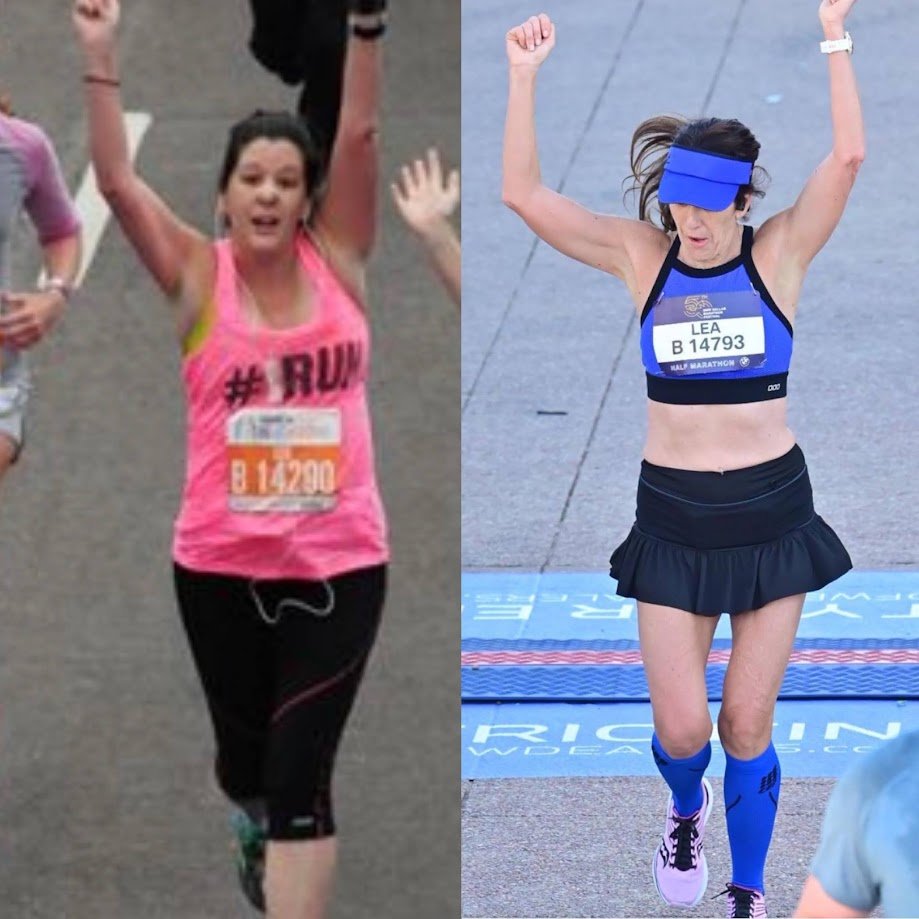Before I go into the ways to lose weight without counting calories (or macros), as a caveat, I'm not implying that calories or macros don't matter— they do. You lose weight when you burn more calories than consume. The problem is how many calories you burn and how many you consume are moving targets that can be affected by many factors.
Even if you do a professional test to get your metabolic rate (the number of calories you burn just to stay alive), it's not so cut and dry. That number can change in time, and then when you factor in what you are consuming and how many calories you are burning during exercise and intentional movement, it gets a bit muddy.
Your treadmill, Apple watch, or heart-rate monitor may tell you how many calories you burn during exercise, but be aware, they are estimates, and likely over-estimated. Machines and fitness trackers are making estimates based on your weight and heart-rate. Still, these numbers can vary drastically per person depending on body weight, body composition, and metabolic rate.
The bottom line is we are likely not burning as many calories as we think. It doesn't mean you shouldn't do it, don't put so much stock into how many calories you are burning during exercise.
It's a better exercise (pun intended) to focus on building lean muscle so that your metabolic rate improves. With more muscle tissue, you burn more calories just to stay alive, which means you can eat more and still maintain or lose weight.
I don't mean that you should train to look like a bodybuilder (if you don't want to) but instead perform resistance training exercises to maintain and build lean muscle. Need help? That's why I am here.
The amount of calories you consume is also somewhat of a guessing game—even if you weigh and measure every morsel. Nutrition labels are permitted to be off by up to 20% in either direction because farmers and food manufacturers can't produce identical batches on a large scale. So legally 300 calories on a label could be 240-360 in actuality.
I guess that for marketing purposes, they are more likely to round down than up, so you could be eating more calories than you think—even when you measure. So your cardio machine is rounding up the calories you are burning, and the food manufacturers might be rounding down. No wonder this can feel so hard.
If you like to count calories and macros, then, by all means, keep doing it. I don't want you to stop doing something that is working for you. I do it periodically to make sure I am staying on track. This article is for those of us that don't like to track, weigh, and measure every morsel (or have a tendency to get obsessive) but want to make better choices to achieve or maintain a healthy weight.
Use Hand Portions
I love Precision Nutrition's hand portion guide. If you are not counting calories, hand portions can give you an easy way to estimate portion sizes. We can control how much we are eating by controlling portions. Portion control can put us into that calorie-deficit that we need to lose weight without counting calories.
FOR WOMEN
One palm-sized portion of protein-dense foods with each meal
One fist-sized portion of vegetables with each meal
One cupped hand-filled portion of carbohydrates with most meals
One thumb-sized portion of fat with each meal
FOR MEN
Two palm-sized portions of protein-dense foods with each meal
Two fist-sized portions of vegetables with each meal
Two cupped hand-filled portions of carbohydrates with most meals
Two thumb-sized portions of fat with each meal
The key to portion control with the hand method is to adjust as needed. Because we are all individuals, hand portions are a starting point, and you make the changes based on what your body needs. If you need more protein, add another palm size. If you want fewer carbohydrates, reduce the portion on some meals, and increase the fat portion.
If you lose too much weight, add in more portions. If you gain weight (and that is not your goal), then reduce portions. Outcome-based decision making means you look at your actions and the results they produce and make appropriate changes until you reach your goal.
There is a starting point that we can all follow, but there is not a one-size-fits-all solution to your individual caloric needs.
Eat Slowly
I never realized how fast I inhaled my food until I learned that we feel fuller, and digest better when we chew slowly and rest between bites. Try to eat less like my dog Dale when I give him a treat (and he tries to eat my hand too) but much more leisurely.
Eating slowing can assist you in eating less because often, we continue to eat after we are full because it takes twenty minutes to send and receive the signal that we're full. If you inhale three servings in under twenty minutes, you may not realize you overdid it until it is too late.
A few tips to eat slowly:
Try to make each meal last at least twenty minutes. Set the alarm to see how long it takes you to complete your meal, and attempt to stretch it out a bit longer next time. Put down the fork between bites.
Chew each bite thoroughly, try to count bites between 20-30 times.
Eat mindfully, think about each bite, the taste, and the texture. Often junk foods don't taste as good as we think once we slow down and taste them.
Remove distractions. Eating while staring at your phone (guilty!), watching TV, or working at your computer may cause you to eat mindlessly and over-consume. Just eating slower can aid in weight loss because it may cause you to eat a bit less at meals.
Eat More Protein and Vegetables
Protein helps us feel fuller between meals and has a higher thermic effect, which means you burn more calories to process it with digestion and absorption than other types of foods.
Protein intake helps you maintain the muscle tissue you have and, combined with resistance training, will promote building muscle. The more muscle you carry around, the higher your metabolism, which helps with losing fat (you burn more calories at rest) and makes maintaining fat loss easier.
Vegetables have low calories with high nutrient-density, which can help you feel fuller while consuming fewer calories. An effective fat loss diet, even one that isn't counting calories or macros, will benefit from consuming adequate protein and vegetables, and for many people that means increasing over your current intake.
Sleep Well
If you feel like you are doing everything right, but not seeing the results you desire, I'd challenge you to look at your sleep quality and quantity. Adequate sleep helps regulate and balance hormones, control hunger, and manage stress—all essential for fat loss. Aim for seven to nine quality hours of sleep per night.
While everyone is looking for the magic pill or weight loss supplement, they may be overlooking the basics: sleep and stress-reducing strategies that can aid in weight loss.
Ways to improve sleep
Turn off electronics an hour or two before bed
Journal before bed to help clear your head
Set a nighttime alarm to get to bed at around the same time each night
Wake up about the same time each morning (within an hour, even on the weekends)
Avoid caffeine and alcohol for better sleep quality
Limit water intake in the hours leading up to bedtime to avoid the middle of the night bathroom breaks
Set up your environment for success. A cool, dark room is usually best. Turn off the TV and keep your phone in another place.
Reduce or Eliminate Processed Foods
Another way to improve your diet without counting calories is to improve the quality of the foods that you are consuming. Reduce or eliminate processed foods from your diet (but occasional indulgences are encouraged).
Food companies specifically manufacture processed foods to make them easy to overeat. They don't even try to hide it; remember that potato chip commercial "Betcha can't eat just one!" They encourage you to overeat.
Whole foods from nature are easier to control portions and have more nutrients, so you feel more satisfied when eating less. Think how easy it is to consume 800-1000 calories in a pizza, you'd be hard-pressed to consume that many calories with chicken and vegetables.
Aim to eat the most minimally processed versions of foods, the closer to the way it is in nature, the better — apples instead of store-bought apple sauce, potatoes instead of french fries, fish instead of frozen fish sticks. You get the idea.
Simpy eating higher quality foods can aid in weight loss with calorie counting because you are less likely to overeat those types of foods.
BONUS TIPS TO LOSE FAT WITHOUT COUNTING CALORIES
Add more intentional low-intensity movement into your day, such as walking and taking the stairs. Over time it adds up.
Make resistance training a priority in your training. Muscle tissue uses more energy (burns calories) at rest than fat, so increasing muscle and decreasing fat improves your metabolism.
Drink enough water to stay hydrated. Dehydration can feel like hunger. Start with half your body weight in ounces and adjust up or down as needed. There is no one size fits all.
Using at least one of these strategies can aid in your fat loss journey without calorie counting, however, if you combine all five ideas, plus the bonus tips into your daily habits, you will have even more success.
Do you like the control of counting calories or find it too tedious, like me? There is no right or wrong answer, only we can decide for ourselves what works best for our bodies.
Did you like this post? Do you know someone who might benefit? It helps me when you share with your friends and followers on Facebook, Twitter, or Pinterest.
Questions? I’d love to help.













